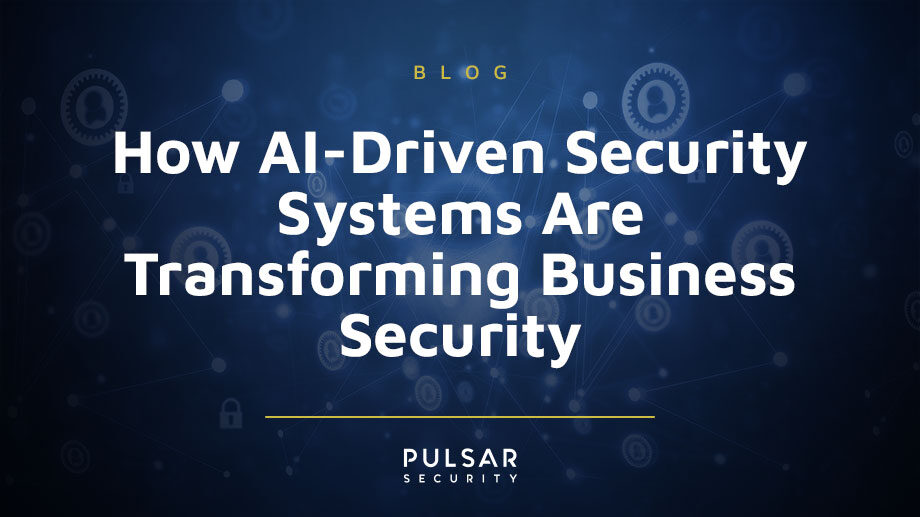How AI-Driven Security Systems are Transforming Business Security
In a period dominated by technological advancements, the corporate cybersecurity landscape has experienced a substantial transformation. The advent of Artificial Intelligence (AI) has marked a pivotal shift in the field, radically altering the methods businesses employ to safeguard their IT resources, assets, and information.
Owing to its capacity to analyze enormous quantities of data, identify trends, and execute instantaneous judgments, AI promises to enhance our approach to digital security. This is particularly relevant in an age where data breaches and cyber threats are increasingly common, underscoring the need for robust, AI-driven security measures.
The integration of AI with cybersecurity is not a novel development. It has historical origins that extend back to the inception of computing technology. As society started to comprehend the revolutionary capabilities of computers, it was concurrently confronted with the nascent risks associated with them.
This highlighted the urgent need for automated security systems to identify, comprehend, and neutralize potential security threats and risks. Relentless innovation, hurdles, and evolution have marked the fusion of AI and cybersecurity. This evolution continues today, with AI playing an increasingly critical role in shaping the future of cybersecurity.
The Potential of AI in Cybersecurity
AI is a pillar of strength in enhancing organizational security measures in a rapidly changing digital environment where cyber threats persistently loom. Here are some of the prospective advantages of AI in cybersecurity and how this potent technology can revolutionize our strategy toward digital safety.
1. Enhanced Threat Detection Accelerated Response Times
One of the most significant contributions of AI to cybersecurity is its unmatched ability for threat detection and expedited response. In contrast to rule-based systems that find it challenging to adapt to the ever-changing strategies of cybercriminals, AI utilizes machine learning algorithms to analyze extensive datasets in real time. It can pinpoint irregularities and potential threats, enabling ultra-fast detection and immediate, pre-emptive responses. This proficiency is crucial in averting data breaches and reducing the repercussions of cyberattacks. It is essential in today’s digital landscape, where the sophistication and frequency of cyber threats are on the rise.
2. Augmented Automation for Routine Cybersecurity Processes
AI-driven cybersecurity solutions provide a notable edge by automating routine cybersecurity tasks that previously required significant human intervention. AI-enabled tools can efficiently manage processes such as monitoring network traffic continuously, pinpointing vulnerabilities, and implementing security patches. Subsequently, this lightens the burden on cybersecurity teams and lessens the likelihood of human errors in these monotonous tasks.
3. Increased Scalability and Flexibility
Scalability and flexibility are paramount in the modern cyber threat environment, where attackers devise more sophisticated attacks daily. AI-enabled security systems can scale to manage growing data volumes and an increasing count of interconnected devices. Furthermore, they can adapt and continuously learn from emerging threat patterns, perpetually enhancing their proficiency to secure digital ecosystems. Achieving such flexibility is crucial in a scenario where cyber threats persistently transform and evolve. It is particularly relevant in today’s interconnected world, where enterprises implement numerous digital infrastructures to leverage their benefits and strengthen their competitive advantage.
4. Boosting Incident Response and Remediation
AI technologies play a significant role in augmenting response and remediation. AI algorithms can be programmed to execute specific actions autonomously to respond to identified threats. For instance, they can segregate impacted devices, block harmful IP addresses, or alert the relevant security teams of the actions they must take to address detected threats. Essentially, AI-driven cybersecurity helps minimize the duration required to respond to an assault and mitigate further harm.
Moreover, AI can evaluate the root causes of various security occurrences more effectively than humans. It facilitates the identification and rectification of inherent vulnerabilities. Consequently, you’ll experience quicker incident resolution and a reduced likelihood of future attacks from the same vulnerability. AI-driven incident response and remediation enhance the effectiveness of cybersecurity measures and contribute to the resilience and robustness of digital infrastructures.
5. Forecasting and Averting Cyber Attacks
One of the most powerful applications of AI in cybersecurity is its capability to forecast and avert cyberattacks before they transpire. AI employs proactive threat intelligence to amass and analyze data to discern emerging attack patterns, threats, and trends. As such, it enables security teams to stay abreast of potential risks and implement defensive measures against them before they actualize.
In addition, AI technologies conduct scans across applications, devices, and networks for known and unidentified vulnerabilities. Hence, they facilitate vulnerability patching before attackers can exploit them. Such an anticipatory approach to vulnerability management assists organizations in maintaining a sturdy security stance and minimizes the probability of successful attacks.
What does this mean for your organization?
The traditional IT environment encompasses numerous risks associated with privacy, boundary safeguards, software applications, or data breaches. These risks are typically deemed vulnerable as they create gaps and undermine an organization’s defensive stance. The counter-strategy is to mitigate these risks and enhance cyber protection.
Integrating AI into the risk and vulnerability landscape revolutionizes security compliance and organizational cybersecurity preparedness. Given that AI leverages behavioral analytics, real-time analytics, and machine learning, businesses can analyze risks based on patterns and computational discrepancies. AI tools and continuous monitoring work best in such scenarios. Also, it allows organizations to determine how assessments, audits, configuration modifications, and remediation timelines evolve.
More importantly, enterprises aiming to maintain their competitive edge must adopt AI-powered tools with new capabilities. In conjunction with their security teams’ and AI specialists’ expertise, this will enable a more comprehensive understanding and protection against the ever-changing risk environment. Cybersecurity has been harnessing the power of AI for several years, and this trend has gained momentum recently. Presently, AI is incorporated into a wide array of cybersecurity tools, contributing to the enhancement of threat identification, response, and the overall security of data, networks, and systems.
Besides integrating these tools into existing cybersecurity processes, organizations must cultivate collaboration across the entire enterprise. They should do so under the guidance of AI specialists and cybersecurity professionals and focus primarily on applying risk management best practices tailored to the organization’s security needs. This should involve a comprehensive and robust strategy for conducting regular security assessments and audits to identify, evaluate, and rectify potential vulnerabilities, and also implement data security, privacy, and security measures that evolve in line with the organization’s findings.
In other words, incorporating AI into cybersecurity strategies enhances the effectiveness of risk detection and mitigation and contributes to the overall resilience of an organization’s IT infrastructure.
Challenges in Implementing AI-Driven Cybersecurity
While the advantages of AI in cybersecurity are extensively recognized, adopting this technology can present challenges. The core of the issue is that entities such as small businesses and public sector organizations often struggle to update their systems and respond promptly, primarily due to constraints in budget and expertise. Economic instabilities or uncertainties can also compel them to constrict their budgets across all sectors, including cybersecurity.
Nonetheless, utilizing AI doesn’t necessarily have to be costly—its benefits can be harnessed within a budget. For example, security teams can initiate the process by conducting a comprehensive risk assessment to detect and prioritize potential cybersecurity threats to their organization. These threats could range from weak authentication and insider threats to data breaches.
As an alternative, organizations can delegate specific cybersecurity tasks to cybersecurity firms. These firms offer specialized knowledge and tools on a subscription model and can alleviate the necessity for substantial in-house investments.
Another hurdle is that incorporating AI into pre-existing infrastructure can be sophisticated. Businesses frequently have various existing systems, applications, and technologies amassed over time. These systems may not be inherently designed to function harmoniously with novel AI solutions. Hence, evaluating the compatibility of existing systems with AI solutions and prioritizing AI solutions that emphasize interoperability and compatibility with various systems is crucial.
Starting your AI-powered cybersecurity Journey with Pulsar Security
Pulsar Security can be a valuable partner for organizations embarking on their AI-powered cybersecurity journey. With its expertise in AI and cybersecurity, Pulsar Security can provide organizations with the necessary tools and guidance to effectively leverage AI to enhance their cybersecurity posture. This includes AI-powered solutions for threat detection, response, and remediation and predictive analytics for proactive threat management. These solutions can help organizations identify and address vulnerabilities, thereby reducing the likelihood of successful cyberattacks and ensuring the integrity and security of their digital assets.
Moreover, Pulsar Security can also assist organizations in navigating the challenges associated with integrating AI into their IT infrastructure. This includes assessing the compatibility of existing systems with AI solutions and prioritizing AI solutions. By doing so, Pulsar Security can help organizations seamlessly incorporate AI into their cybersecurity strategies, enhancing their ability to address vulnerabilities and respond to cyber threats proactively.
Furthermore, Pulsar Security can offer cost-effective solutions for organizations facing budget and talent constraints. This includes the option to outsource certain cybersecurity functions, thereby reducing the need for extensive in-house investments. Pulsar Security can also guide organizations in conducting thorough risk assessments and implementing data privacy and security measures that evolve with the organization’s findings. In this way, Pulsar Security can help organizations realize the benefits of AI in cybersecurity, even on a budget.

Peyton Somerville
Peyton is a Security Engineer at Pulsar Security. He is the technical contact for our customers - managing all Cyber Shield Vulnerability and Dark Web Assessments, and is on the Red Team. He has software development experience with Python, JavaScript, C, C++. He has earned his Offensive Security Certified Professional (OSCP), Network+ and Security+ certifications. Peyton first started with Pulsar as a intern while attending the University of Massachusetts - Lowell as a Computer Science major. He now leads the Pulsar Explore Internship Program ensuring all interns engage in hands-on learning, interactive mentorship, and learn about cyber career opportunities. Fun Fact: Peyton loves to snowboard, and even knows how to juggle.




